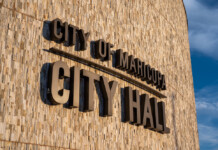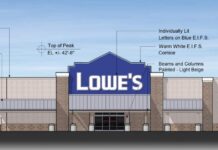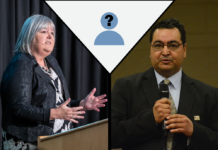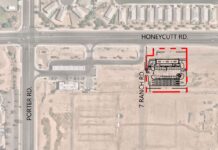
The Arizona State Transportation Board approved its five-year plan June 19 with $36.2 million to install a State Route 347 overpass at the railroad tracks.
“The state really saw the significance of the project,” Transportation Board member Kelly Anderson said. “It’s a safety issue with the trains crossing through town, by the high school and by so many businesses. The overpass will also get rid of the barrier between the north and south sides of town. It will even out Maricopa, and we’ll have one seamless city and one seamless region.”
Construction is not set to begin until 2020, according to the Department of Transportation’s plan, which is allocating the majority of the money for the overpass. For some, the process seems like it is dragging on way too long. For those who are involved in the project like Mayor Christian Price, the process is moving at an incredible rate.
“People always say ‘why does it take five years?’” Price said. “Roadways and the dollars that go into it are very tough to come by. In this economy, especially in this post-recessionary world, they’re even harder to get. So it’s really a tough gig to get a federal roadway built. When you add federal bureaucracy and you add environmental assessments and all the different things that go into a roadway using federal money, it takes a long time.”
Price is the first to admit until he started working on bringing roads to Maricopa, he had no idea how much effort and time went into making it happen. The overpass has taken more than a decade so far, but projects such as Loop 101 and Loop 202 in Phoenix took nearly twice as long.
“There’s so much behind the scenes,” Price said. “Myself and Kelly and the Ak-Chin Community have really tried to step up the knowledge to the people about what goes into the process prior to completion.”
According to Anderson, a former mayor of Maricopa, the grade separation project has been seen as a need for the city since Maricopa incorporated in 2003. However, the project also plays an important role in the future development of Pinal County and southern Arizona.
“When the city became a city, [the overpass] was one of our top priorities,” Anderson said. “It was clear from the start how important it would be. It’s really become a western Pinal County project, and state project. It will connect the city to the Ak-Chin community, and commuters to Interstate 8.”
Overpass construction will be separated into three phases. The first phase is relocating the Amtrak station to the business center next to Firehouse 575. The second phase realigns traffic flow from Maricopa-Casa Grande Highway to Honeycutt Road. To speed the process leading up to the actual construction of the bridge, the city will look to partners such as Pinal County and the Ak-Chin Indian Community for any remaining funds.
In addition to Amtrak, other Heritage District businesses will be relocated. It will not be up to the city to decide which, however. ADOT, which is taking over the design process, will decide based on the route the new road will take and right-of-way needed.
“Even though the city has led the charge on this to get it done, once it’s in the plan like it is now, it becomes a state project,” Price said. “Since it is part of State Route 347, the state does everything. The city is out at this point. We say, ‘This is your project and we’re here to help in any way we can.’ But it’s the state that will be making those (business) determinations. It is our jobs to help those businesses the best we can and be an advocate to the state for them.”
For the city, the next step is to get the word out about the project, and help the state select the right contractor to build the bridge. At 30-percent design completion, impacted property owners will be notified.
The expected construction time is 18 to 24 months.
“The construction itself is so quick,” Price said. “You’re in this project for 15 years, and all of the sudden the bridge gets thrown up. At the end of the day, the bridge can be done in 18 months. The actual construction is the easy part. It’s all the stuff that goes into it before that’s the hard part.”
During the incorporation campaign, Ed Farrell, who was later appointed the city’s first mayor, went door to door promising Heritage District residents the city wouldn’t change. Price faces the task of growing his city to its prosperous potential, while upholding the small-town nature of its past. This is a challenge he welcomes, but hopes the members of the community who wish to see it stay true to its roots realize he can’t sacrifice projects such as the overpass to benefit the few.
“I think it requires balance,” Price said. “I always take [Farrell’s promise to the Heritage District] into consideration, but at the same time we have to look at how progress meets old world. That progress is the nature of where the train tracks sit. The nature of the way the 347 is the lifeblood, the artery that moves the city of Maricopa backwards and forwards. It is what supplies the entire southern half of what Maricopa might some day become. You cannot leave it as is. It has to change if it’s going to be successful.”
Price said he supports keeping things the way they are as best he can, and he wants to be sensitive to longtime members of the community.
The basis for all overpass decisions is developing a thriving economy in Maricopa. As Phoenix and Tucson communities grow toward each other, eventually each area will run out of space and hit a reservation. The only areas left to develop will be in Maricopa and Casa Grande. To facilitate future growth, Maricopa must have adequate transportation avenues, the mayor said.
“The key to economic development is transportation,” Price said. “You have to be able to get places. You have to be able to get people to and from their homes, and they have to feel like they can do it in a timeframe that doesn’t take them away from their families. You have to have a good transportation system if you want a strong economy.”
Price quipped the love he developed for transportation surprised him. His time in office has shown him roads are needed to build a thriving economy better. If Maricopa is going to reach its full potential, it needs highways and interstates, he said.
“From a regional perspective, [the overpass] is very important,” Pinal County District 4 Supervisor Anthony Smith, a former Maricopa mayor, said. “It serves all of the communities of the city. It also serves all of the areas surrounding the city such as the Ak-Chin, Gila River and Hidden Valley communities. It’s a plus for all regional transportation.”
Currently, accessibility is still an issue. However, if members of the city government have it their way, the overpass will just be the beginning of transportation and economic development in the city. An east-west corridor is being planned to connect Maricopa to Interstate 10, and the potential for the proposed Interstate 11 to run along the west side of town exists.
“Interstate 11 is a dream of mine since I very first heard about it,” Price said. “This is something we need to get on board with and pursue. At the end of the day, it may take 20 years to get, but we need to push for it.”
I-11 is slated to run from Las Vegas, Nevada, to Wickenburg. According to Price, it doesn’t currently go past Wickenburg because developers haven’t decided on a route. Price and the city belong to the “I-11 Coalition,” which hopes to sway developers to bring I-11 all the way to Nogales through Maricopa, instead of utilizing existing highways that are underused.
Price believes the key to maximizing traffic efficiency is to develop a new freeway system, not try to resurrect an old one.
***ADVERTISEMENT***“Transportation is the missing link to economic development,” Price said. “If we could have I-11 coming through Maricopa and say, ‘We have the direct route from Las Vegas to Nogales where the trade is coming in,’ that’s $22 billion in commerce coming up that road. Now it’s coming right through Maricopa. That would change our economic dynamic picture in a way we have never comprehended. That’s the vision, and that’s why we have to push for transportation.”



![Elena Trails releases home renderings An image of one of 56 elevation renderings submitted to Maricopa's planning department for the Elena Trails subdivison. The developer plans to construct 14 different floor plans, with four elevation styles per plan. [City of Maricopa]](https://www.inmaricopa.com/wp-content/uploads/2024/04/city-041724-elena-trails-rendering-218x150.jpg)
![Affordable apartments planned near ‘Restaurant Row’ A blue square highlights the area of the proposed affordable housing development and "Restaurant Row" sitting south of city hall and the Maricopa Police Department. Preliminary architectural drawings were not yet available. [City of Maricopa]](https://www.inmaricopa.com/wp-content/uploads/2024/04/041724-affordable-housing-project-restaurant-row-218x150.jpg)

![City looks to lower property taxes again City Manager Ben Bitter speaks during a Chamber of Commerce event at Global Water Resources on April 11, 2024. Bitter discussed the current state of economic development in Maricopa, as well as hinting at lowering property tax rates again. [Monica D. Spencer]](https://www.inmaricopa.com/wp-content/uploads/2024/04/spencer-041124-ben-bitter-chamber-property-taxes-web-218x150.jpg)






![Alleged car thief released without charges Phoenix police stop a stolen vehicle on April 20, 2024. [Facebook]](https://www.inmaricopa.com/wp-content/uploads/2024/04/IMG_5040-218x150.jpg)



